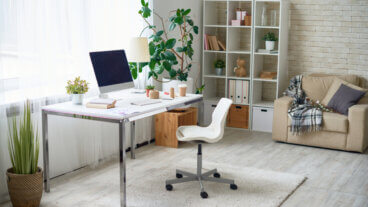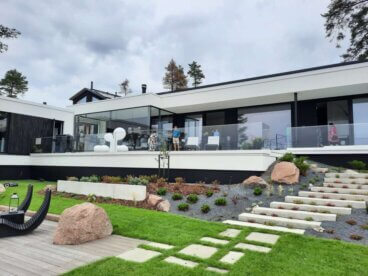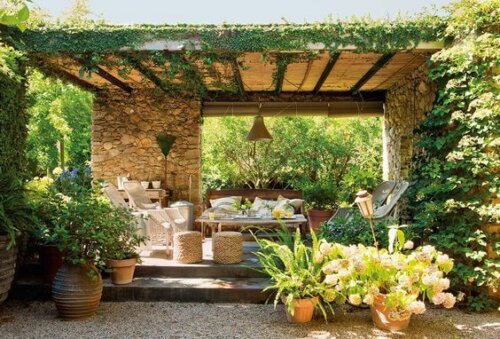Bathroom Tiles - A Decorative Element in Demand

For many people, tiles are the ideal wall covering. Traditional ceramic bathroom tiles have changed a lot over the years, adapting to new styles and trends with ease. Here are just some of the different advantages of using tiles in your home:
- They’re highly resistant to extremes of temperature.
- They’re waterproof.
- They come in a variety of different shapes, colors, and finishes.
- They’re available in a wide range of styles and prices.
Tiles are mainly used to line walls. Until a few years ago, many people chose to cover their walls in tiles from top to bottom. This was a really effective method, which helped to reduce the effects of moisture and make bathrooms easier to clean.
Today, however, people normally only tile part of their walls, up to a height of roughly 55 – 70 inches. They then cover the upper half of the walls with a second material, usually a coat of damp-proof paint.
Bathroom tiles – everything you need to know
Tiles are usually made of ceramic, clay or a mixture of fine ceramic and enamel. However, you can also find vitreous, semi-vitreous and absorbent tiles.
We should also mention vitreous stoneware mosaic tiles. These revive the tradition of ancient mosaics while adding a modern vitrified finish.
Size and finishes

Tiles come in a range of different designs and finishes. They can also be decorated with fretwork and borders, which can be made from ceramic, or other materials, such as wood. This is a great way to break any potential monotony.
Tiles can have a glossy, satin or matte finish. The first two are designed to give the tiles a bright, shiny appearance, making the room feel spotlessly clean, while matte tiles are ideal for modern, urban-style homes.
When it comes to tiles, there is no “standard” size. 6 x 6 ” tiles are one of the most popular formats, but modern trends tend to favor larger, rectangular tiles, which give walls an elegant and formal feel.
These are highly recommended for large bathrooms, as they’re quick and easy to install. That said, they’re also great for smaller bathrooms, as they can help make rooms look larger and more spacious.
Colors
Most people tend to be conservative when it comes to the colors they use in their home, choosing neutral and pale tones such as cream, beige and tan.
Another classic option is white, which is typically combined with blue. However, more and more people are choosing Mediterranean-inspired color combinations, such as yellow and white, and green and white.
Different ways to decorate with bathroom tiles

If you have white bathroom fittings, you may want to consider choosing brighter colors for your tiles. That way, you can add a touch of contrast, and give your bathroom a more modern feel.
You can also combine a variety of different tile colors. For example, you could choose one color for one section, and cover the adjacent section with tiles of the same color, but in a slightly different shade.
Cleaning your bathroom tiles
To keep your tiles sparkling clean, mix equal parts rubbing alcohol and ammonia with 20 fl oz of water. Add a splash of concentrated detergent, then soak a cloth in the mixture and start scrubbing your tiles.
The grout between the tiles can be bleached using a mixture of pumice powder and borax, which you can apply using an esparto grass scourer.
Calculating the number of tiles you need

In this final section, we’re going to show you how to accurately calculate the number of tiles you’ll need to line your bathroom. Put these tips into practice, and you’ll be able to get it right every time.
When it comes to tiling, you have to pay special attention to the number of tiles you’ll need to use. You don’t want to buy too many, as this will mean unnecessary expenses, but neither do you want to run out of tiles before you finish.
Now that we’ve underlined the importance of buying the right amount of materials, you’ll need to take measurements so that you know exactly how many tiles you need to buy.
To do this, you need to measure the length of the wall. Multiply it by the height to find the total area of the wall you wish to tile.
Taking into account that tiles are usually purchased per square foot, you’ll need to know how high up your wall you wish to place your tiles, as well as how many walls you wish to cover, and whether you wish to add a border.
Last but not least, it’s a good idea to save several samples of your tiles and borders in case you need to do any repairs later on.
So, are you ready to start tiling your walls?
For many people, tiles are the ideal wall covering. Traditional ceramic bathroom tiles have changed a lot over the years, adapting to new styles and trends with ease. Here are just some of the different advantages of using tiles in your home:
- They’re highly resistant to extremes of temperature.
- They’re waterproof.
- They come in a variety of different shapes, colors, and finishes.
- They’re available in a wide range of styles and prices.
Tiles are mainly used to line walls. Until a few years ago, many people chose to cover their walls in tiles from top to bottom. This was a really effective method, which helped to reduce the effects of moisture and make bathrooms easier to clean.
Today, however, people normally only tile part of their walls, up to a height of roughly 55 – 70 inches. They then cover the upper half of the walls with a second material, usually a coat of damp-proof paint.
Bathroom tiles – everything you need to know
Tiles are usually made of ceramic, clay or a mixture of fine ceramic and enamel. However, you can also find vitreous, semi-vitreous and absorbent tiles.
We should also mention vitreous stoneware mosaic tiles. These revive the tradition of ancient mosaics while adding a modern vitrified finish.
Size and finishes

Tiles come in a range of different designs and finishes. They can also be decorated with fretwork and borders, which can be made from ceramic, or other materials, such as wood. This is a great way to break any potential monotony.
Tiles can have a glossy, satin or matte finish. The first two are designed to give the tiles a bright, shiny appearance, making the room feel spotlessly clean, while matte tiles are ideal for modern, urban-style homes.
When it comes to tiles, there is no “standard” size. 6 x 6 ” tiles are one of the most popular formats, but modern trends tend to favor larger, rectangular tiles, which give walls an elegant and formal feel.
These are highly recommended for large bathrooms, as they’re quick and easy to install. That said, they’re also great for smaller bathrooms, as they can help make rooms look larger and more spacious.
Colors
Most people tend to be conservative when it comes to the colors they use in their home, choosing neutral and pale tones such as cream, beige and tan.
Another classic option is white, which is typically combined with blue. However, more and more people are choosing Mediterranean-inspired color combinations, such as yellow and white, and green and white.
Different ways to decorate with bathroom tiles

If you have white bathroom fittings, you may want to consider choosing brighter colors for your tiles. That way, you can add a touch of contrast, and give your bathroom a more modern feel.
You can also combine a variety of different tile colors. For example, you could choose one color for one section, and cover the adjacent section with tiles of the same color, but in a slightly different shade.
Cleaning your bathroom tiles
To keep your tiles sparkling clean, mix equal parts rubbing alcohol and ammonia with 20 fl oz of water. Add a splash of concentrated detergent, then soak a cloth in the mixture and start scrubbing your tiles.
The grout between the tiles can be bleached using a mixture of pumice powder and borax, which you can apply using an esparto grass scourer.
Calculating the number of tiles you need

In this final section, we’re going to show you how to accurately calculate the number of tiles you’ll need to line your bathroom. Put these tips into practice, and you’ll be able to get it right every time.
When it comes to tiling, you have to pay special attention to the number of tiles you’ll need to use. You don’t want to buy too many, as this will mean unnecessary expenses, but neither do you want to run out of tiles before you finish.
Now that we’ve underlined the importance of buying the right amount of materials, you’ll need to take measurements so that you know exactly how many tiles you need to buy.
To do this, you need to measure the length of the wall. Multiply it by the height to find the total area of the wall you wish to tile.
Taking into account that tiles are usually purchased per square foot, you’ll need to know how high up your wall you wish to place your tiles, as well as how many walls you wish to cover, and whether you wish to add a border.
Last but not least, it’s a good idea to save several samples of your tiles and borders in case you need to do any repairs later on.
So, are you ready to start tiling your walls?







